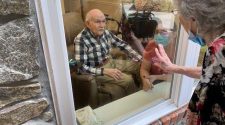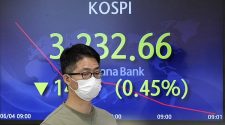Are you a medical provider who has become sick with covid-19? If so, we’d love to hear your story. Please send me a note at [email protected].
Thanks for reading Health 202, especially now. Sign up here and forward our daily health policy tipsheet to your friends, family and colleagues.
THE PROGNOSIS
President Trump speaks about the coronavirus on Monday. (Alex Brandon/AP)
Amid the rush to supply hospitals with ventilators, there’s a sad truth: At least half of covid-19 patients who require ventilators don’t survive.
As many as two-thirds of these critically ill patients — who struggle to breathe as their lungs fill up with fluid — end up succumbing to the illness caused by the novel coronavirus, according to early reporting on deaths out of China, Italy and the United States. While helpful, ventilators are far from a miracle cure for the virus sweeping through the United States.
“They’re called life support for a reason — they just keep people alive while typically buying time for something else to heal the lungs,” Scott Halpern, a bioethicist at the University of Pennsylvania, told our colleagues Carolyn Y. Johnson and Ariana Eunjung Cha.
Ventilators are used, typically in intensive care units, to assist patients with breathing by helping the lungs inhale and exhale air. The process involves inserting a tube into a patient’s mouth or nose and down their windpipe. Mechanical ventilators are often used on patients with brain injury, stroke or when they have pneumonia (a condition often resulting from influenza).

New York Gov. Andrew Cuomo briefs the media inside a nearly completed makeshift hospital at the Jacob Javits Convention Center in New York. (Darren McGee/Office of Governor Andrew M. Cuomo via AP)
Hospitals short on ventilators amid a surge of covid-19 patients are one of the most pressing worries of public health leaders as the country tries to mobilize against the virus. Chief among the problem areas is New York City, where Gov. Andrew M. Cuomo (D) has said the state received 1,000 ventilators from the Chinese government and another 140 from Oregon. Last Thursday, Trump announced he was using the Defense Production Act to ensure several companies including General Electric and Medtronic get the materials they need to build ventilators.
Trump struck a typically boastful tone at last night’s press briefing, promising the government is “ready to roll” with “almost 10,000” ventilators from the national stockpile and more being built by private industry. But the president has been in an ongoing argument with governors who say they’re not getting what they need from the federal government in terms of ventilators, masks and gowns – called personal protective equipment – with Trump claiming those needs might be exaggerated.
“Wherever that monster goes, we’re able to move with it,” the president said. “We have people ready and waiting to bring them.”
Here’s what studies suggest about covid-19 patients who are sick enough to be put on a ventilator:
— According to London’s Intensive Care National Audit and Research Centre study on 165 critically ill patients in England, Wales and Northern Ireland, 66 percent of patients who received respiratory support died.
That’s significantly more than patients who typically die after being put on ventilators. Just 36 percent of these patients died from 2017 to 2019, according to the study.
— Nine out of 18 covid patients on ventilators in Seattle-area hospitals died and just six had recovered enough to breathe on their own, according to a study published Monday in the New England Journal of Medicine.
The researchers noted these patients needed especially high oxygen requirements soon after being intubated — and that patients typically required the ventilator for longer than a week.
“The earliest extubation occurred 8 days after initiation of invasive mechanical ventilation, which suggests that acute respiratory failure due to Covid-19 may require prolonged mechanical ventilation lasting days to weeks,” they wrote.
— In another study of critically ill patients in Wuhan, China, where the virus originated, 30 out of 37 patients who received ventilation died.

So even if the Trump administration follows through on bold promises to deliver more ventilators to undersupplied hospitals, that can only go so far in stemming a death toll research models say could reach 100,000 or more in the United States.
Yesterday, a widely cited model from the University of Washington’s Institute for Health Metrics and Evaluation (IHME) slightly downgraded its national fatality prediction from 82,141 deaths to 81,766 deaths, although that model conflicts with several others projecting deaths, equipment shortages and projected peaks. Some state leaders are growing increasingly concerned about how the White House is using the University of Washington model to deny state requests for equipment and help in preparations, Carolyn and William Wan report.
“The stark differences between the IHME model and dozens of others being created by states exposes the glaring lack of national models provided publicly by the White House or agencies such as the Centers for Disease Control and Prevention for local leaders to use in planning or preparation,” they write.
FiveThirtyEight’s Nate Silver tracks the daily death rate:
Newly-reported US COVID-19 deaths:
Mon 4/6—1182
Sun 4/5—1184
Sat 4/4—1352
Fri 4/3—1178
Thu 4/2—1084
Wed 4/1—954
Tue 3/31—807
Mon 3/30—511
Sun 3/29—463
Sat 3/28—435
Fri 3/27—367
Thu 3/26—263
Wed 3/25—225
Tue 3/24—204
Mon 3/23—73
Sun 3/22—126
Sat 3/21—53
Fri 3/20—59
Thu 3/19—48— Nate Silver (@NateSilver538) April 6, 2020
And for patients who survive being put on a ventilator, a host of other challenges await.
“Many will suffer long-term physical, mental and emotional issues, according to a staggering body of medical and scientific studies,” Carolyn and Ariana write. “Even a year after leaving the intensive care unit, many people experience post-traumatic stress disorder, Alzheimer’s-like cognitive deficits, depression, lost jobs and problems with daily activities such as bathing and eating.”
“Patients with covid-19 typically stay on ventilators for prolonged periods which increases the likelihood of long-term complications,” they add. “The risk of infection also means they are cut off from human contact, which also increases the risk of psychological issues.”
“We normally kneel at their bedside and hold their hand and ask them, ‘How are you’ and tell them, ‘It is my privilege to help you.’ Instead what they are getting is someone in spacesuit garb with very little time to spend with them,” E. Wesley Ely, a professor at Vanderbilt University in Nashville, told our colleagues.
AHH, OOF and OUCH

Stephen Hahn, commissioner of the U.S. Food and Drug Administration. (Sarah Silbiger/Getty Images)
AHH: The Food and Drug Administration yesterday approved the first coronavirus antibody test in the U.S. This kind of test looks for protective antibodies in the blood to inform doctors “whether a patient has ever been exposed to the virus and now may have some immunity,” the New York Times’s Apoorva Mandavilli reports.
If people do have immunity, that could allow them to leave their homes safely. These tests will also help scientists better understand how widespread the infection is, which could help researchers calculate a more accurate death rate and help them understand how long people are immune to the virus after they recover.
“The new test, made by Cellex, looks for two types of antibodies: immunoglobulin M, made by the body a few days into an infection; and immunoglobulin G, made later but created specifically to neutralize a particular invader,” Apoorva writes. “The test delivers results in about 15 minutes. But just having antibodies does not guarantee immunity from the coronavirus.”

Trump listens as Brett Giroir, U.S. assistant secretary for health, right, speaks during a White House briefing. Photographer: Stefani Reynolds/CNP/Bloomberg
— Say what? Brett Giroir, an assistant Health and Human Services secretary who was named the top administration official on the testing effort, said yesterday there’s no antibody test approved yet.
“Approved is not a word we talk about,” Giroir said at last night’s coronavirus briefing.
He clarified that “a test or two that has received emergency use authorization, and many, many, many others out there that have not gone that way yet.”
“And I want to take this opportunity to caution, there is a very consolidated effort between the FDA, CDC, NIH to validate some of the tests that are on the market right now because it is very important that they actually do what they say they do,” Giroir added.
— Our colleagues Yasmeen Abutaleb, Josh Dawsey, Ellen Nakashima and Greg Miller reported over the weekend on how the U.S. “will likely go down as the country that was supposedly best prepared to fight a pandemic but ended up catastrophically overmatched by the novel coronavirus, sustaining heavier casualties than any other nation.”
“The most consequential failure involved a breakdown in efforts to develop a diagnostic test that could be mass produced and distributed across the United States, enabling agencies to map early outbreaks of the disease, and impose quarantine measures to contain them,” they write. “At one point, a Food and Drug Administration official tore into lab officials at the Centers for Disease Control and Prevention, telling them their lapses in protocol, including concerns that the lab did not meet the criteria for sterile conditions, were so serious that the FDA would ‘shut you down’ if the CDC were a commercial, rather than government, entity.”

President Trump speaks about the coronavirus. (Alex Brandon/AP)
OOF: A new report from the Department of Health and Human Services’s inspector general supports the troubling warnings from governors and health-care workers who say hospitals are dealing with dire shortages. It details a dearth of supplies, including protective gear and tests, as hospitals scramble to address this pandemic.
For some hospitals, that means making their own hand sanitizer, or searching for face masks from nail salons and auto-body shops, our colleague Amy Goldstein reports. The report is based on a survey conducted at the end of last month of 343 hospitals in 46 states.
The report details serious shortages in testing kits and personal protective equipment, and noted the difficulty in maintaining an adequate amount of on-duty staff, as well as the “emotional toll” on doctors and other medical workers.
“The report is the first public federal critique of the capacity of the nation’s hospitals to cope with the flood of infected patients in coronavirus hot spots — an inundation likely to arrive elsewhere soon,” Amy writes. “In substantiating complaints about inadequate equipment, it essentially counters assertions by President Trump that hospitals and state officials advocating for them are being greedy.”
— At Monday’s coronavirus briefing, Trump dismissed the report’s findings as “just wrong.” Asked about details from the report, he called for the inspector general’s name. “So, give me the name of the inspector general. Could politics be entered into that?” he said.
PBS NewsHour’s Yamiche Alcindor:
Pres Trump today pushed back on report by HHS inspector general that found US hospitals are facing “severe” & “widespread” shortages of much needed medical supplies, hurting their ability to test & respond to coronavirus adequately & protect staff
Report: https://t.co/KPN4B3p6In
— Yamiche Alcindor (@Yamiche) April 6, 2020
Our colleague JM Rieger:
Trump on the acting HHS inspector general:
“When was she appointed? Would you do me a favor: let me know? No, no, let me know now. I have to know now”
The previous HHS IG resigned a year ago this week.
Trump has yet to nominate a replacement.https://t.co/NsWUBawIUE pic.twitter.com/lz5AcGkUun
— JM Rieger (@RiegerReport) April 6, 2020

Wisconsin Gov. Tony Evers (D). (Steve Apps/Wisconsin State Journal/AP)
OUCH: Confusion continues over Wisconsin’s Democratic primary and local elections scheduled to be held today. The Wisconsin Supreme Court yesterday blocked an executive order by Gov. Tony Evers (D) to stop today’s in-person voting.
The court’s decision launched a “final scramble for election officials to prepare polling places and protect voters and workers hours before balloting was scheduled to begin,” our colleagues Amy Gardner, Elise Viebeck and Dan Simmons report. “ … The rapid-fire series of developments unleashed a torrent of confusion across Wisconsin. After Evers issued the order, some local governments announced that voting was canceled, while state officials urged election clerks to proceed as if the polls would open. Legal experts, meanwhile, questioned whether Evers’s actions were constitutional.”
The chaos signals trouble for the other states determining how to plan for primaries amid the spreading pandemic. “It also foreshadowed the likelihood that Wisconsin, by some measures the most important presidential battleground state, could become the epicenter of partisan rancor as the health crisis continues to upend the 2020 race,” our colleagues add.
— Democratic groups are seizing opportunities to escalate their general election campaign against the president.
Some have “targeted his failure to act urgently to deflect the damage the coronavirus is wreaking over lives and the economy, as he brushed aside intelligence briefings and warnings from health officials while holding fundraisers and gathering thousands of his followers at rallies,” our colleagues Toluse Olorunnipa and Annie Linskey report. “Their greatest ammunition? Trump’s own comments, aired daily in the marathon coronavirus briefings where he commands center stage.”
The Democratic super PAC Priorities USA has spent more than $7.5 million running an ad in states that could determine the November election.
“We could run a 10-minute ad every hour, and still not scratch the surface of how the president has misinformed people and sent contradictory messages,” said Guy Cecil, chairman of Priorities USA.

Former vice president Joe Biden speaks from his basement. (Biden for President via AP)
— Trump told reporters he had a 15-minute phone conversation with former vice president Joe Biden about the pandemic, calling it a “really wonderful, warm conversation.”
“We talked about pretty much this. This is what we talked about. This is what everyone’s talking about,” the president said. “This is what they want to talk about. And he gave me his point of view, and I fully understood that.”
— As Sen. Bernie Sanders (I-Vt.) remains in the race, his deliberations about the future of his campaign have “exposed divisions in his movement between die-hard liberal activists with little appetite to fall in line behind former vice president Joe Biden and more conventional Democrats who see some merit in Sanders (I-Vt.) withdrawing from the race,” our colleagues Sean Sullivan and David Weigel report.
They add: “Those close to Sanders say he is focused heavily on the coronavirus crisis and they are not certain what he will decide. Over the past few weeks, he has used his campaign as a vehicle to champion the liberal ideas he believes the government should adopt to combat the crisis, such as universal health care coverage.”
— Other news to catch up on this morning:
The Trump administration’s efforts:
- Peter Navarro, Trump’s trade adviser, warned the administration late in January that the “coronavirus crisis could cost the United States trillions of dollars and put millions of Americans at risk of illness or death,” the New York Times’s Maggie Haberman reports. Navarro wrote in a memo that a “lack of protection elevates the risk of the coronavirus evolving into a full-blown pandemic, imperiling the lives of millions of Americans.”
- The Biomedical Advanced Research and Development Authority was established to invest in drug development projects for crisis moments like this. “Lawmakers were so confident that BARDA could help scientists develop a coronavirus vaccine, therapy, or even a diagnostic test that Congress has showered the agency with a $3.5 billion boost in funding, more than tripling its total budget,” Stat News’s Nicholas Florko reports. “But consultants and experts in biotech and in academia told STAT they had serious concerns about BARDA’s preparedness to absorb the massive new workload it will take to identify targets for a coronavirus vaccine or therapy.”
In the DMV area:
The hardest hit:
- Our colleagues add the data released in D.C., which for the first time included a breakdown by race, “showed that deaths are disproportionately concentrated among black residents, as has been the case elsewhere in the country.”
- Our colleague Robert Samuels reports in this dispatch from Milwaukee that 33 of the 45 residents who died of covid-19 in Milwaukee County were black. “That’s 73 percent, though black residents made up fewer than half of the county’s coronavirus infections and about 28 percent of the total county population,” he writes. “The disparity is even more glaring when looking statewide: Black residents here represent nearly half of the coronavirus-related deaths in Wisconsin, a state that is 6 percent black.”
The economy:
- Economists warn the economy won’t be fully up and running again until people “are confident that they can go about their business without a high risk of catching the virus,” the New York Times’s Jim Tankersley reports.
- Many of the workers deemed essential during the pandemic are also among the lowest paid in the nation, our colleague Christopher Ingraham reports. There are four key reasons, he explains, citing interviews with economists across the ideological spectrum.
On the front lines:
- In recent days, at least four employees from major supermarket chains have died, leading to store closures and increased anxiety among grocery store workers, our colleague Abha Bhattarai reports.
- In Los Angeles, suicide hotlines have seen an increase in coronavirus-related calls, the Los Angeles Times’s Brittny Mejia reports. One nonprofit, Didi Hirsch Mental Health Services, said crisis counselors received more than 1,800 coronavirus-related calls in March, and one out of five of those included “suicidal desire.”
Good to know:
- Austria and Denmark were the first European countries to announce plans to ease coronavirus-related lockdowns, reopening societies in a signal they may have “weathered the worst of the first wave of the pandemic,” our colleague Michael Birnbaum reports.
- New York, New Jersey and Louisiana’s governors pointed to preliminary signs coronavirus cases are starting to level off but warned that residents should be cautiously optimistic and not complacent, Reuters’s Nathan Layne and Peter Szekely report. “New hospital admissions are trending downward,” said Louisiana Gov. John Bel Edwards (R) at a news conference. “But this will only become a trend if we keep mitigation efforts up.”
How we could avoid a repeat of all this:
- A “wet market” in Wuhan has been linked to the first coronavirus cases, where at least one store sold creatures including wolf cubs and masked palm civets for consumption. “Such markets, experts say, feature stressed and ill animals stacked in cages, bodily fluids sprinkling down, as well as butchering — prime conditions for viral spillover,” our colleague Karin Brulliard reports.
- China, which briefly stopped the trade in civets after the SARS outbreak, in January announced a ban on the transport and sale of wild animals, but only until the coronavirus epidemic is eliminated.

















